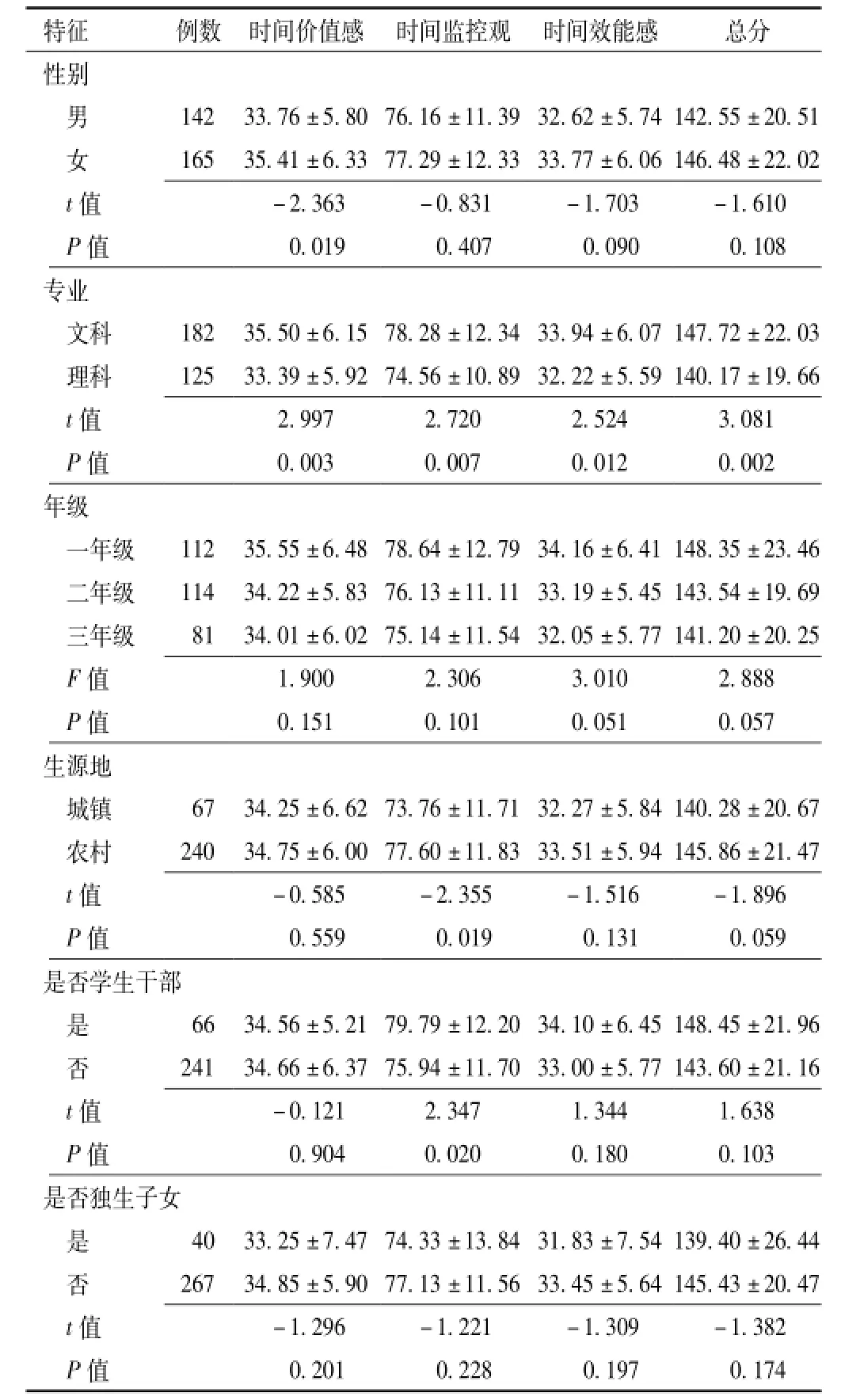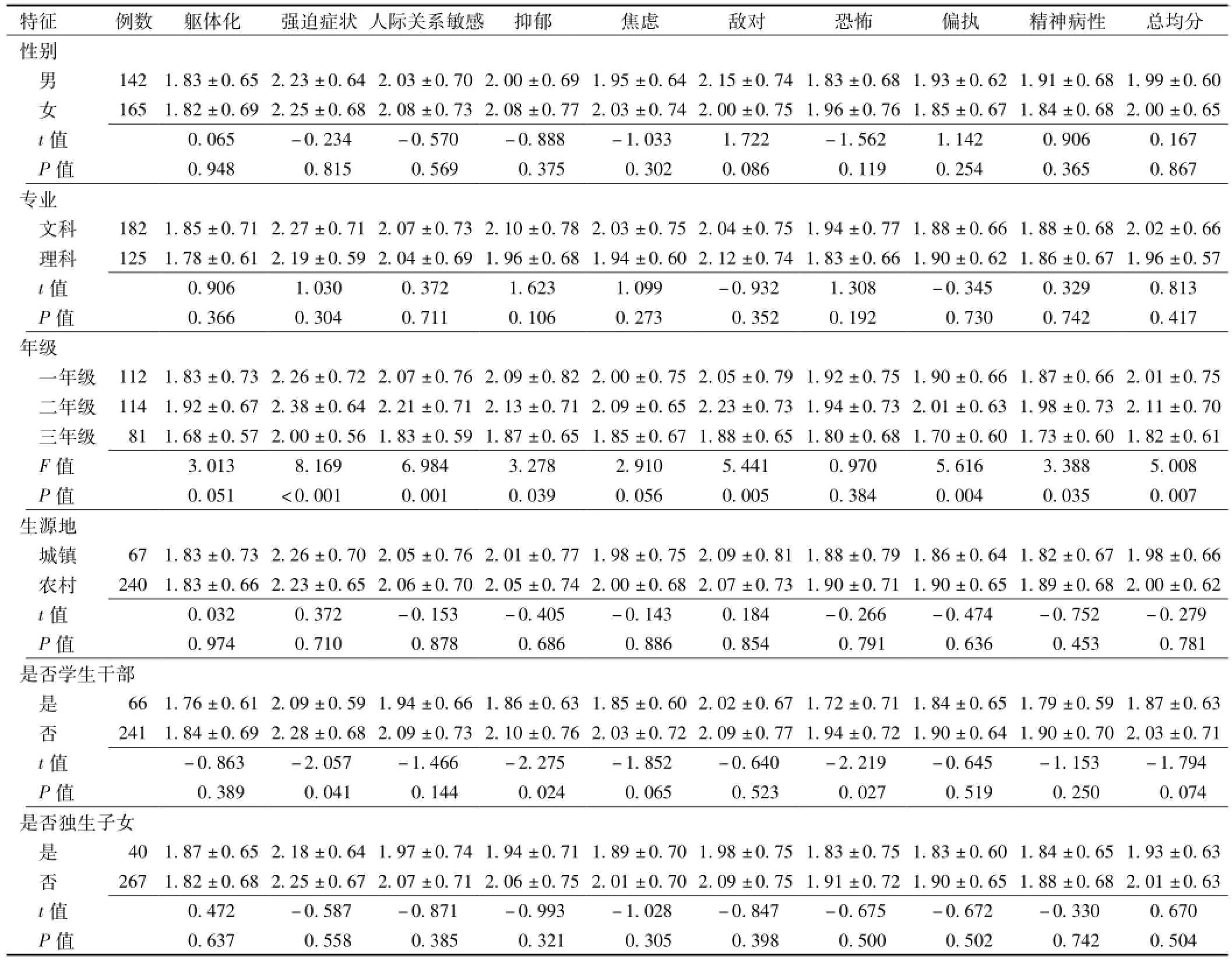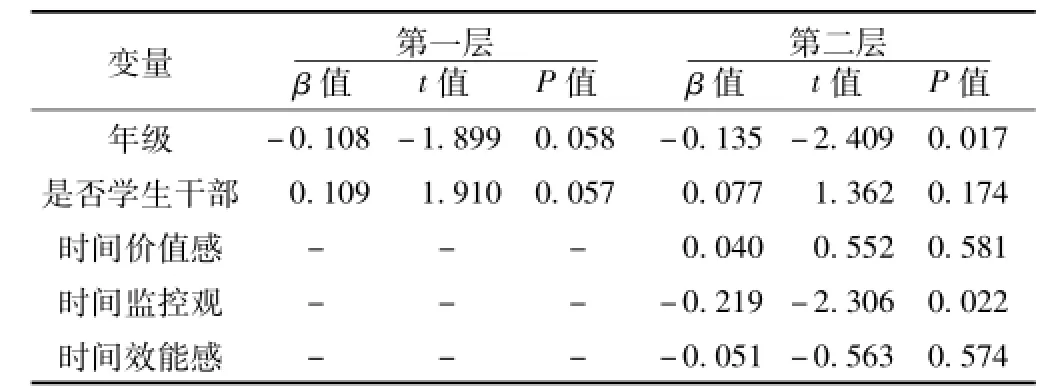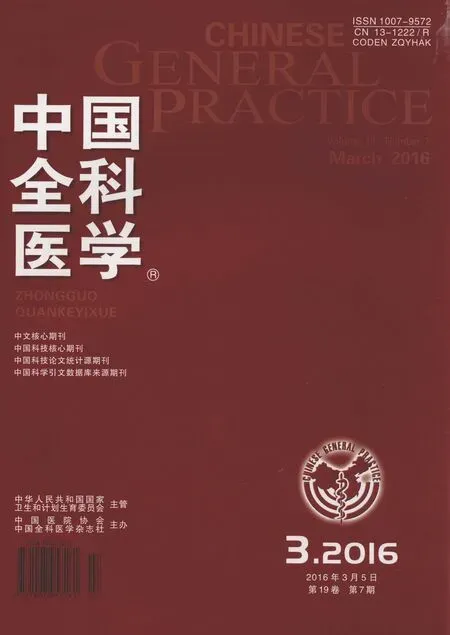高职学生时间管理倾向、心理健康水平及二者的关系研究
石贵莹,周明洁
高职学生时间管理倾向、心理健康水平及二者的关系研究
石贵莹,周明洁
目的了解高职学生时间管理倾向、心理健康水平,并探讨二者之间的关系。方法于2014年5—6月选取甘肃省3所高职院校学生307例,采用青少年时间管理倾向量表(ATMD)和症状自评量表(SCL-90)以班为单位对高职学生的时间管理倾向和心理健康水平进行集体测试。时间管理倾向得分与心理健康得分的相关分析采用Pearson相关分析;时间管理倾向各维度对心理健康的预测作用采用分层回归分析。结果307例高职学生,ATMD总均分为(144.65±21.39)分,其中时间价值感、时间监控观、时间效能感分量表得分分别为(34.64±6.13)、(76.77±11.90)、(33.23±5.93)分;SCL-90总均分为(2.00±0.70)分。不同性别的高职学生时间价值感得分间差异有统计学意义(P<0.05),而时间监控观、时间效能感得分及总均分间差异无统计学意义(P>0.05)。不同专业的高职学生时间价值感、时间监控观、时间效能感得分及总均分间差异均有统计学意义(P<0.05)。不同年级、是否独生子女的高职学生时间价值感、时间监控观、时间效能感得分及总分间差异均无统计学意义(P>0.05)。不同生源地、是否学生干部的高职学生时间价值感、时间效能感得分及总分间差异无统计学意义(P>0.05),而时间监控观得分间差异有统计学意义(P<0.05)。不同性别、专业、生源地及是否独生子女的高职学生SCL-90各因子得分及总均分间差异均无统计学意义(P>0.05)。不同年级的高职学生SCL-90除躯体化、焦虑、恐怖外其余因子得分及总均分间差异有统计学意义(P<0.05)。是否学生干部的高职学生强迫症状、抑郁、恐怖得分间差异有统计学意义(P<0.05),而SCL-90其余因子得分及总均分间差异无统计学意义(P>0.05)。高职学生SCL-90各因子得分均高于全国青年常模,差异有统计学意义(P<0.05)。高、低时间管理倾向得分的高职学生SCL-90各因子得分及总均分间差异均有统计学意义(P<0.05)。时间价值感得分与躯体化、恐怖、精神病性得分均呈线性负相关(P<0.05),而与SCL-90其余因子得分及总均分无线性相关关系(P>0.05);时间监控观得分及总分与SCL-90各因子得分及总均分均呈线性负相关(P<0.05);时间效能感得分与SCL-90除强迫症状、人际关系敏感外的其余因子得分及总均分均呈线性负相关(P<0.05)。当控制了人口学变量后,时间监控观对心理健康症状有负向预测作用(P<0.05)。结论高职学生时间管理能力尚可,心理健康水平普遍较低,时间管理倾向中的时间监控观对心理健康有明显预测作用。
高职学生;时间管理倾向;心理健康
石贵莹,周明洁.高职学生时间管理倾向、心理健康水平及二者的关系研究[J].中国全科医学,2016,19(7):842-847.[www.chinagp.net]
ShiGY,Zhou MJ.Time management disposition and mental health status of vocational college students and the relation between them[J].Chinese General Practice,2016,19(7):842-847.
时间管理倾向是个体在运用时间方式上所表现出来的心理和行为特征,是一种时间维度上的人格特点。黄希庭等[1]提出了时间管理倾向的概念和相应的三维理论模型,并编制了青少年时间管理倾向量表,认为时间管理倾向包括时间价值感、时间监控观和时间效能感3个维度。秦启文等[2]的研究表明时间管理倾向与心理健康之间存在一定程度的相关,时间管理倾向及其各维度与心理健康各因子的相关主要集中在躯体化、抑郁和焦虑等及总症状指数上。牟丽霞等[3]的研究发现时间管理倾向总分与人际关系敏感、敌对、精神病性、偏执这些因子有明显负相关,时间监控观对心理健康总体水平有一定的预测功能。孙慧等[4]研究表明,高心理健康水平的学生在时间管理能力方面明显高于低水平者。此外,这方面研究还涉及时间管理倾向与个体焦虑、抑郁、压力等心理健康多个维度之间的关系[5-8]。但以往相关研究多以本科学生为研究对象,而高职学生较本科学生而言,大多数在中学期间未能养成良好的学习习惯,如自学能力差、时间观念不强,做事拖拉、没有计划,自控能力弱等,学习成绩不是很好,很少得到老师与同学的重视和肯定,而且高职类的课程专业性较强,学生容易产生无聊、失望等消极情绪[9]。本研究旨在探讨高职学生时间管理倾向与心理健康水平之间的关系。
1 资料与方法
1.1 一般资料 于2014年5—6月选取甘肃省3所高职院校学生307例,其中男142例(46.3%),女165例(53.7%);年龄为18~23岁,平均为20.8岁;一年级112例(36.5%),二年级114例(37.1%),三年级81例(26.4%);文科182例(59.3%),理科125例(40.7%);城镇学生67例(21.8%),农村学生240例(78.2%);独生子女40例(13.0%),非独生子女267例(87.0%);学生干部66例(21.5%),普通学生241例(78.5%)。
1.2 方法 采用问卷调查法,以班为单位对高职学生的时间管理倾向和心理健康水平进行集体测试,由主试统一指导语,一次性完成调查问卷所有题目。共发放问卷330份,回收有效问卷307份,问卷有效回收率为93.0%。
1.2.1 青少年时间管理倾向量表(ATMD) 由黄希庭等[1]编制,共44个条目,由时间价值感、时间监控观和时间效能感3个分量表组成,其中时间价值感包括社会取向和个人取向2个维度;时间监控观包括设置目标、计划、优先级、时间分配和反馈性5个维度;时间效能感包括时间管理效能和时间管理行为效能2个维度,各分量表按5点等级计分。量表各维度的内部一致性信度系数为0.62~0.81,重测信度系数为0.71~0.85。
1.2.2 症状自评量表(SCL-90) 由Derogatis.L.R.编制(1975年),1984年由王征宇等修订[10],包括9个症状因子,即躯体化、强迫症状、人际关系敏感、抑郁、焦虑、敌对、恐怖、偏执、精神病性。量表采用5分的评分标准,反映不同程度的症状。其内部一致性系数为0.61~0.96。
1.3 统计学方法 采用SPSS 17.0统计软件进行统计学分析。计量资料以(±s)表示,两组间比较采用t检验,多组间比较采用方差分析;时间管理倾向得分与心理健康得分的相关分析采用Pearson相关分析;时间管理倾向各维度对心理健康的预测作用采用分层回归分析。以P<0.05为差异有统计学意义。
2 结果
2.1 高职学生时间管理倾向与心理健康总分情况 307例高职学生,ATMD总分为(144.65±21.39)分,其中时间价值感、时间监控观、时间效能感分量表得分分别为(34.64 ±6.13)、(76.77±11.90)、(33.23±5.93)分;SCL-90总均分为(2.00±0.70)分。
2.2 不同特征高职学生时间管理倾向得分比较 不同性别的高职学生时间价值感得分间差异有统计学意义(P<0.05),而时间监控观、时间效能感得分及总均分间差异无统计学意义(P>0.05)。不同专业的高职学生时间价值感、时间监控观、时间效能感得分及总均分间差异均有统计学意义(P<0.05)。不同年级、是否独生子女的高职学生时间价值感、时间监控观、时间效能感得分及总分间差异均无统计学意义(P>0.05)。不同生源地、是否学生干部的高职学生时间价值感、时间效能感得分及总分间差异无统计学意义(P>0.05),而时间监控观得分间差异有统计学意义(P<0.05,见表1)。
2.3 不同特征高职学生心理健康得分比较 不同性别、专业、生源地及是否独生子女的高职学生SCL-90各因子得分及总均分间差异均无统计学意义(P>0.05)。不同年级的高职学生SCL-90除躯体化、焦虑、恐怖外其余因子得分及总均分间差异有统计学意义(P<0.05);其中三年级高职学生强迫症状、人际关系敏感、抑郁、偏执得分及总分与一、二年级比较,三年级高职学生敌对、精神病性得分与二年级比较,差异均有统计学意义(P<0.05)。是否学生干部的高职学生强迫症状、抑郁、恐怖得分间差异有统计学意义(P<0.05),而SCL-90其余因子得分及总均分间差异无统计学意义(P>0.05,见表2)。
2.4 高职学生心理健康得分与全国青年常模比较 高职学生SCL-90各因子得分与全国青年常模比较,差异均有统计学意义(P<0.05,见表3)。
2.5 高、低时间管理倾向得分的高职学生心理健康得分比较
将被试按照时间管理倾向总得分,由高到低进行排序,取前27%为高时间管理倾向组,后27%为低时间管理倾向组,比较两组心理健康得分情况。结果显示,两组SCL-90各因子得分及总均分间差异均有统计学意义(P<0.05,见表4)。2.6 时间管理倾向得分与心理健康得分的相关分析 时间价值感得分与躯体化、恐怖、精神病性得分均呈线性负相关(P<0.05),而与SCL-90其余因子得分及总均分无线性相关关系(P>0.05);时间监控观得分及总分与SCL-90各因子得分及总均分均呈线性负相关(P<0.05);时间效能感得分与SCL-90除强迫症状、人际关系敏感外的其余因子得分及总均分均呈线性负相关(P<0.05,见表5)。
表1 不同特征高职学生时间管理倾向得分比较(±s,分)Table 1 Comparison of the score of time management disposition among vocational college studentswith different features

表1 不同特征高职学生时间管理倾向得分比较(±s,分)Table 1 Comparison of the score of time management disposition among vocational college studentswith different features
性别男1 4 2 3 3 . 7 6 ± 5 . 8 0 7 6 . 1 6 ± 1 1 . 3 9 3 2 . 6 2 ± 5 . 7 4 1 4 2 . 5 5 ± 2 0 . 5 1女1 6 5 3 5 . 4 1 ± 6 . 3 3 7 7 . 2 9 ± 1 2 . 3 3 3 3 . 7 7 ± 6 . 0 6 1 4 6 . 4 8 ± 2 2 . 0 2 t-2 . 3 6 3-0 . 8 3 1-1 . 7 0 3-1 . 6 1 0 P值值0 . 0 1 9 0 . 4 0 7 0 . 0 9 0 0 . 1 0 8专业文科1 8 2 3 5 . 5 0 ± 6 . 1 5 7 8 . 2 8 ± 1 2 . 3 4 3 3 . 9 4 ± 6 . 0 7 1 4 7 . 7 2 ± 2 2 . 0 3理科1 2 5 3 3 . 3 9 ± 5 . 9 2 7 4 . 5 6 ± 1 0 . 8 9 3 2 . 2 2 ± 5 . 5 9 1 4 0 . 1 7 ± 1 9 . 6 6 t 2 . 9 9 7 2 . 7 2 0 2 . 5 2 4 3 . 0 8 1 P值值0 . 0 0 3 0 . 0 0 7 0 . 0 1 2 0 . 0 0 2年级一年级1 1 2 3 5 . 5 5 ± 6 . 4 8 7 8 . 6 4 ± 1 2 . 7 9 3 4 . 1 6 ± 6 . 4 1 1 4 8 . 3 5 ± 2 3 . 4 6二年级1 1 4 3 4 . 2 2 ± 5 . 8 3 7 6 . 1 3 ± 1 1 . 1 1 3 3 . 1 9 ± 5 . 4 5 1 4 3 . 5 4 ± 1 9 . 6 9三年级 8 1 3 4 . 0 1 ± 6 . 0 2 7 5 . 1 4 ± 1 1 . 5 4 3 2 . 0 5 ± 5 . 7 7 1 4 1 . 2 0 ± 2 0 . 2 5 F值1 . 9 0 0 2 . 3 0 6 3 . 0 1 0 2 . 8 8 8 P值0 . 1 5 1 0 . 1 0 1 0 . 0 5 1 0 . 0 5 7生源地城镇 6 7 3 4 . 2 5 ± 6 . 6 2 7 3 . 7 6 ± 1 1 . 7 1 3 2 . 2 7 ± 5 . 8 4 1 4 0 . 2 8 ± 2 0 . 6 7农村2 4 0 3 4 . 7 5 ± 6 . 0 0 7 7 . 6 0 ± 1 1 . 8 3 3 3 . 5 1 ± 5 . 9 4 1 4 5 . 8 6 ± 2 1 . 4 7 t-0 . 5 8 5-2 . 3 5 5-1 . 5 1 6-1 . 8 9 6 P值值0 . 5 5 9 0 . 0 1 9 0 . 1 3 1 0 . 0 5 9是否学生干部是 6 6 3 4 . 5 6 ± 5 . 2 1 7 9 . 7 9 ± 1 2 . 2 0 3 4 . 1 0 ± 6 . 4 5 1 4 8 . 4 5 ± 2 1 . 9 6否2 4 1 3 4 . 6 6 ± 6 . 3 7 7 5 . 9 4 ± 1 1 . 7 0 3 3 . 0 0 ± 5 . 7 7 1 4 3 . 6 0 ± 2 1 . 1 6 t-0 . 1 2 1 2 . 3 4 7 1 . 3 4 4 1 . 6 3 8 P值值0 . 9 0 4 0 . 0 2 0 0 . 1 8 0 0 . 1 0 3是否独生子女是 4 0 3 3 . 2 5 ± 7 . 4 7 7 4 . 3 3 ± 1 3 . 8 4 3 1 . 8 3 ± 7 . 5 4 1 3 9 . 4 0 ± 2 6 . 4 4否2 6 7 3 4 . 8 5 ± 5 . 9 0 7 7 . 1 3 ± 1 1 . 5 6 3 3 . 4 5 ± 5 . 6 4 1 4 5 . 4 3 ± 2 0 . 4 7 t-1 . 2 9 6-1 . 2 2 1-1 . 3 0 9-1 . 3 8 2 P值值0 . 2 0 1 0 . 2 2 8 0 . 1 9 7 0 . 1 7 4
表2 不同特征高职学生心理健康得分比较(±s,分)Table 2 Comparison of the score ofmental health among vocational college studentswith different features

表2 不同特征高职学生心理健康得分比较(±s,分)Table 2 Comparison of the score ofmental health among vocational college studentswith different features
特征例数躯体化强迫症状人际关系敏感抑郁焦虑敌对恐怖偏执精神病性总均分性别男142 1.83±0.65 2.23±0.64 2.03±0.70 2.00±0.69 1.95±0.64 2.15±0.74 1.83±0.68 1.93±0.62 1.91±0.68 1.99±0.60女165 1.82±0.69 2.25±0.68 2.08±0.73 2.08±0.77 2.03±0.74 2.00±0.75 1.96±0.76 1.85±0.67 1.84±0.68 2.00±0.65 t 2 1.142 0.906 0.167 P值0.948 0.815 0.569 0.375 0.302 0.086 0.119 0.25值0.065-0.234-0.570-0.888-1.033 1.722-1.56 4 0.365 0.867专业文科182 1.85±0.71 2.27±0.71 2.07±0.73 2.10±0.78 2.03±0.75 2.04±0.75 1.94±0.77 1.88±0.66 1.88±0.68 2.02±0.66理科125 1.78±0.61 2.19±0.59 2.04±0.69 1.96±0.68 1.94±0.60 2.12±0.74 1.83±0.66 1.90±0.62 1.86±0.67 1.96±0.57 t 345 0.329 0.813 P值0.366 0.304 0.711 0.106 0.273 0.352 0.192 0.73值0.906 1.030 0.372 1.623 1.099-0.932 1.308-0. 0 0.742 0.417年级一年级112 1.83±0.73 2.26±0.72 2.07±0.76 2.09±0.82 2.00±0.75 2.05±0.79 1.92±0.75 1.90±0.66 1.87±0.66 2.01±0.75二年级114 1.92±0.67 2.38±0.64 2.21±0.71 2.13±0.71 2.09±0.65 2.23±0.73 1.94±0.73 2.01±0.63 1.98±0.73 2.11±0.70三年级 81 1.68±0.57 2.00±0.56 1.83±0.59 1.87±0.65 1.85±0.67 1.88±0.65 1.80±0.68 1.70±0.60 1.73±0.60 1.82±0.61 F值6 3.388 5.008 P值0.051<0.001 0.001 0.039 0.056 0.005 0.384 0.0 3.013 8.169 6.984 3.278 2.910 5.441 0.970 5.61 04 0.035 0.007生源地城镇 67 1.83±0.73 2.26±0.70 2.05±0.76 2.01±0.77 1.98±0.75 2.09±0.81 1.88±0.79 1.86±0.64 1.82±0.67 1.98±0.66农村240 1.83±0.66 2.23±0.65 2.06±0.70 2.05±0.74 2.00±0.68 2.07±0.73 1.90±0.71 1.90±0.65 1.89±0.68 2.00±0.62 t-0.474-0.752-0.279 P值0.974 0.710 0.878 0.686 0.886 0.854 0.791 0.63值0.032 0.372-0.153-0.405-0.143 0.184-0.266 6 0.453 0.781是否学生干部是 66 1.76±0.61 2.09±0.59 1.94±0.66 1.86±0.63 1.85±0.60 2.02±0.67 1.72±0.71 1.84±0.65 1.79±0.59 1.87±0.63否241 1.84±0.69 2.28±0.68 2.09±0.73 2.10±0.76 2.03±0.72 2.09±0.77 1.94±0.72 1.90±0.64 1.90±0.70 2.03±0.71 t 219-0.645-1.153-1.794 P值0.389 0.041 0.144 0.024 0.065 0.523 0.027 0.51值-0.863-2.057-1.466-2.275-1.852-0.640-2. 9 0.250 0.074是否独生子女是 40 1.87±0.65 2.18±0.64 1.97±0.74 1.94±0.71 1.89±0.70 1.98±0.75 1.83±0.75 1.83±0.60 1.84±0.65 1.93±0.63否267 1.82±0.68 2.25±0.67 2.07±0.71 2.06±0.75 2.01±0.70 2.09±0.75 1.91±0.72 1.90±0.65 1.88±0.68 2.01±0.63 t 75-0.672-0.330 0.670 P值0.637 0.558 0.385 0.321 0.305 0.398 0.500 0.50值0.472-0.587-0.871-0.993-1.028-0.847-0.6 2 0.742 0.504
表3 高职学生心理健康得分与全国青年常模比较(±s,分)Table 3 Comparison of the score ofmental health between vocational college students and national norm

表3 高职学生心理健康得分与全国青年常模比较(±s,分)Table 3 Comparison of the score ofmental health between vocational college students and national norm
注:因全国青年常模中无总均分,所以未进行总均分比较
7±0.68全国青年常模781 1.34±0.45 1.69±0.61 1.76±0.67 1.57±0.61 1.42±0.43 1.50±0.57 1.33±0.47 1.52±0.60 1.36±0.47 t组别例数躯体化强迫症状人际关系敏感抑郁焦虑敌对恐怖偏执精神病性高职学生307 1.83±0.67 2.24±0.66 2.06±0.71 2.05±0.74 1.99±0.70 2.07±0.74 1.90±0.72 1.89±0.64 1.8 001<0.001<0.001 13 10.051 13.274 P值<0.001<0.001<0.001<0.001<0.001<0.001<0.值13.432 14.454 7.322 11.232 14.442 13.458 13.7
表4 高、低时间管理倾向得分的高职学生心理健康得分比较(±s,分)Table 4 Comparison of the score ofmental health between students with high score of timemanagement disposition and students with low score of time management disposition

表4 高、低时间管理倾向得分的高职学生心理健康得分比较(±s,分)Table 4 Comparison of the score ofmental health between students with high score of timemanagement disposition and students with low score of time management disposition
组别例数躯体化强迫症状人际关系敏感抑郁焦虑敌对恐怖偏执精神病性总均分低时间管理倾向组89 2.00±0.75 2.33±0.65 2.16±0.79 2.22±0.82 2.12±0.73 2.27±0.83 2.11±0.78 2.00±0.65 2.05±0.76 2.15±0.68高时间管理倾向组86 1.58±0.53 2.02±0.58 1.87±0.58 1.78±0.64 1.81±0.61 1.83±0.58 1.65±0.61 1.67±0.49 1.60±0.52 1.76±0.51 t 9 4.456 4.125 P值<0.001 0.002 0.008<0.001 0.004<0.001<0.001值4.216 3.202 2.728 3.866 2.958 3.981 4.222 3.69<0.001<0.001<0.001

表5 时间管理倾向得分与心理健康得分的相关分析(r)Table 5 Correlation analysis between the score of timemanagement disposition and the score ofmental health
2.7 时间管理倾向各维度预测心理健康症状的分层回归分析
考虑到年级、是否学生干部对心理健康症状的影响,进行分层回归,第一层考虑年级、是否学生干部的影响;第二层考察控制了人口学变量后,时间管理倾向3个维度对心理健康症状的影响。结果显示,年级、是否学生干部对心理健康症状的影响无统计学意义(P>0.05);当控制了人口学变量后,时间监控观对心理健康症状有负向预测作用(P<0.05),时间监控观与年级对心理健康症状的联合预测率为0.077,△R2为0.055(见表6)。

表6 时间管理倾向各维度预测心理健康症状的分层回归分析Table 6 Hierarchical regression analysis of the prediction ofmental health symptom by each dimension of timemanagement disposition
3 讨论
3.1 不同特征高职学生时间管理倾向得分的差异分析 本研究结果显示,高职学生时间管理倾向各维度得分与以往研究结果基本一致[12]。高职学生时间管理倾向及其各维度得分不存在年级的差异,这与以往研究结果相一致[12],但存在性别的差异,与赵维燕等[13]研究结果一致。本研究结果显示,男生的时间价值感得分低于女生,这是因为在当今社会,女生的人生追求越来越高,这既来自个体本身,也是在良好的时间管理中得以实现的。就高职学生而言,在专业学习方面男生比女生具有更大的优势,如动手操作能力强、思维抽象化程度高等,所以对女生而言,要想取得较好的成绩,只有更好地利用时间,再加上高校奖学金种类多,金额大,而女生对此更为在乎,所以女生对时间的价值有更充分的认识。理科学生时间管理倾向得分明显低于文科学生,这与邓凌等[5]的研究结果相一致。城镇学生一般更多受到父母的溺爱,很多方面比较依赖父母,当上大学后,在学习生活的目标设置、计划安排、结果检查等一系列监控活动中表现出来的能力会有所欠缺,而农村学生因为生活环境的原因,自理能力相对较强,所以其时间监控观得分高于城镇学生。学生干部较普通学生而言,不仅要搞好学习,还要参与其他方面的很多活动,这使得他们会更好地监控、管理自己的时间,所以时间监控观得分较高,这证实了郭芳等[14]的研究。高职学生不管独生与否,一般在中学阶段未能养成良好的学习习惯,所以时间管理倾向各维度得分不存在是否独生子女方面的差异。
3.2 不同特征高职学生心理健康得分的差异分析 年级方面与以往的研究结果不太一致[15]。从高中到大学的转变中,最显著的一点就是学习方式的转变,一年级学生因为尚未适应大学相对自由的学习环境,对很多可以自己支配的时间没有明确规划,也缺乏很好的自我监控能力,而且有些学生上高职也并非自己心甘情愿,再加上离开了熟悉的环境、朋友,新的人际关系尚未建立,容易产生空虚、无助、迷茫等不良情绪。二年级学生对环境相对适应,但因为专业学习、恋爱、课余活动、等级考试等多方面需要协调,在具体行为操作中经常会与预期的计划目标不协调,容易在敌对、精神病性等方面产生一些变化。相比本科学生,三年级高职学生忙于毕业论文,而且因为就业期望值较小,就业较顺利,所以三年级学生会觉得比较充实,会因为即将开始的新生活而充满激情,心理状态较为良好。高职学生在上中学时多数由于成绩不好,很少得到老师和同学的重视和肯定,自信心水平较低,在上高职后担任学生干部,不仅是对他们综合素质的提升,更多地让他们感受到了成功的喜悦,感受到了尊重和被需要,所以相比普通学生,他们的心理健康水平要高。普通学生则因为以往的失败经验,容易产生“习得性无助感”,在强迫、抑郁、恐怖等方面消极体验明显。性别、文理专业、来自城市还是农村、是否独生子女等方面对高职学生心理健康水平并无太大影响。
3.3 时间管理倾向得分与心理健康得分的相关性分析 本研究结果显示,时间管理倾向各维度及总分与心理健康各因子及总均分之间存在一定程度的相关,特别是时间监控观及总分与心理健康各因子及总均分均存在线性相关关系。时间价值感更多表现在对时间价值的稳定性态度和理解,不是很直接或经常性地对个体心理情绪的变化起作用。时间效能感反映的是个体对时间管理的信心以及对时间管理行为能力的估计,在各因子上的相关程度要比时间价值感高,这可能是因为时间效能感同时也是制约时间监控的一个重要因素。时间监控观是个体利用和运筹时间的能力和观念,其体现在一系列的外显活动中。高职学生在学习、工作等具体的活动领域中更加强调自我监控能力,他们在具体行为操作中经常会与预期的计划目标不协调,较容易产生一些不良的心理状态。本研究结果亦显示,时间管理倾向得分高与得分低的高职学生心理健康各因子得分及总均分间均有差异。时间管理倾向得分高的学生能更好地认识时间的重要性,在生活、学习和工作中都有明确的目标,更善于合理地支配和监控时间,同时良好的时间管理活动有助于降低忧虑和工作中的拖拉现象[16],可以提高做事效率,更易体验成功的喜悦,有助于提高心理健康总体水平。
3.4 时间管理倾向各维度预测心理健康症状的分层回归分析
本研究结果显示,控制年级与是否学生干部之后,时间监控观对心理健康症状有明显预测作用。之前的研究结果也表明,时间监控观对心理健康具有一定的预测力[3,5,12],其更多地表现为个体在运用时间上的心理和行为特征。此外,高职学生心理健康得分与全国青年常模相比较,各因子得分都明显高于全国青年水平。这说明高职学生心理健康水平普遍低于全国青年水平,有必要进一步加强高职学生的心理健康教育工作,提高高职学生心理健康水平。
作者贡献:石贵莹主要进行调查设计与实施、资料收集、撰写论文、成文并对文章负责;周明洁进行评估、质量控制与审校。
本文无利益冲突。
[1]Huang XT,Zhang ZJ.The compiling of adolescence time management disposition inventory[J].Acta Psychologica Sinica,2001,33(4):338-343(in Chinese)黄希庭,张志杰.青少年时间管理倾向量表的编制[J].心理学报,2001,33(4):338-343.
[2]Qin QW,Zhang ZJ.The relationship between time management disposition and mental health[J].Journal of Psychological Science,2002,25(3):360.(in Chinese)秦启文,张志杰.时间管理倾向与心理健康关系的相关研究[J].心理科学,2002,25(3):360.
[3]Mou LX,Wang L.The correlation between time management disposition and mental health[J].China Journal of Health Psychology,2005,15(13):61-63.(in Chinese)牟丽霞,王丽.浙江省高师学生时间管理倾向与心理健康水平的相关研究[J].中国健康心理学杂志,2005,13(1):61-63.
[4]Sun H,Jiang Y,Song SZ.Research on the influence of time management on students′psychological health[J].Journal of Hebei Jiaotong Vocational and Technical College,2011,8(1):73-77.(in Chinese)孙慧,姜宇,宋尚志.时间管理对大学生心理健康状况的影响研究[J].河北交通职业技术学院学报,2011,8(1):73-77.
[5]Deng L,Chen BY.The timemanagement disposition,subjective time pressure and depression of college students[J].Chinese Mental Health Journal,2005,19(10):672-675.(in Chinese)邓凌,陈本友.大学生时间管理倾向、主观时间压力与抑郁的关系[J].中国心理卫生杂志,2005,19(10):672-675.
[6]涂涛,王道阳,方双虎.大学生时间管理倾向、焦虑及其相关性分析[J].中国学校卫生,2009,30(4):356-357.
[7]Wang KX.Correlative research on timemanagement disposition and life satisfaction of university students[J].China Journal of Health Psychology,2009,17(11):1342-1343.(in Chinese)王凯旋.大学生时间管理倾向与生活满意度的相关研究[J].中国健康心理学杂志,2009,17(11):1342-1343.
[8]Huang G,Qin QW,Zhang YH.A research on the relationship among college students,timemanagement disposition,stress and sleep quality[J].Journal of Psychological Science,2009,32(1):170-172.(in Chinese)黄岗,秦启文,张永红.大学生时间管理倾向与压力和睡眠质量的相关研究[J].心理科学,2009,32(1):170-172.
[9]邓莉萍.高职学生心理特点及教育对策研究[D].成都:西南交通大学,2011.
[10]Huang YP,Li L.SCL-90 as measurement of mental health in college students:a meta-analysis[J].Chinese Mental Health Journal,2009,23(5):366-371.(in Chinese)黄艳苹,李玲.用症状自评量表(SCL-90)评估中国大学生心理健康状况的Meta分析[J].中国心理卫生杂志,2009,23(5):366-371.
[11]朱祥路,李鹏,谢平霞,等.医学生症状自评量表与全国诸常模的对比分析[J].中国临床康复,2005,28(1):235.
[12]刘玲玲.大学生时间管理倾向与心理健康的关系研究[D].南昌:江西师范大学,2006.
[13]Zhao WY,Hou RX,Ji F.Relationship between college students′time management disposition and learning burnout[J].China Journal of Health Psychology,2012,20(8):1246-1248.(in Chinese)赵维燕,侯日霞,吉峰.大学生时间管理倾向与学习倦怠的关系研究[J].中国健康心理学杂志,2012,20(8):1246-1248.
[14]Guo F,Qi XD,Wang XL.The relationship of vocational college students′timemanagementdisposition and self efficacy:intermediary role ofmood[J].China Journal of Health Psychology,2013,21(5):754-757.(in Chinese)郭芳,齐晓栋,王晓磊.高职大学生时间管理倾向与自我效能感的关系[J].中国健康心理学杂志,2013,21(5):754-757.
[15]Wang T,Yuan J.197 college students′timemanagement disposition and parenting styles[J].Chinese Mental Health Journal,2008,22(6):429-432.(in Chinese)王婷,袁婕.197名大学生的时间管理倾向与父母教养方式的关系[J].中国心理卫生杂志,2008,22(6):429-432.
[16]Van Eerde W.Procrastination atwork and timemanagement training[J].JPsychol,2003,137(5):421-434.
Time M anagement Disposition and M ental Health Status of Vocational College Students and the Relation Between Them
SHIGui-ying,ZHOU Ming-jie.Key Laboratory of Mental Health&Institute of Psychology,Chinese Academy of Sciences,Beijing 100101,China
ObjectiveTo investigate the timemanagement disposition and mental health status of vocational college students and the relation between them.M ethodsBetween May and June in 2014,we enrolled 307 vocational college students from three vocational colleges in Gansu Province.Using adolescent time management disposition scale(ATMD)and symptom checklist 90(SCL-90),we conducted teston the timemanagementdisposition and mental health level of these students together based on classes.The correlation between the score of timemanagement disposition and the score ofmental health was analyzed by Pearson correlation analysis;the predictive effect of each dimension of time management disposition was analyzed using hierarchical regression analysis.ResultsThe total score of ATMD was(144.65±21.39),and the scores of sense of timevalue,conceptof timemonitor and sense of time potency were(34.64±6.13),(76.77±11.90)and(33.23±5.93),and the total score of SCL-90 was(2.00±0.70).Male students and female students were significantly different in the score of sense of time value(P<0.05),while theywere significantly different in the scores of conceptof timemonitor and sense of time potency and the total score of timemanagement(P>0.05).Students of differentmajorswere significanlty different in the scores of sense of time value,conceptof timemonitor and sense of time potency and the total score of timemanagement(P<0.05). No significant differences existed in the scores of sense of time value,concept of timemonitor and sense of time potency and the total score of timemanagement among students of different grades and between students who were from one-child family and students who were not(P>0.05).No significant differences existed in the scores of sense of time value and sense of time potency and the total score of timemanagement among students from differentplacesand between studentswhowere student cadres and studentswho were not(P>0.05),while significant differencesexisted in the score of concept of timemonitor(P<0.05). No significant differences existed in the score of each SCL-90 factor and the total score of SCL-90 between male students and female students,among students of differentmajors and students from different places,and between studentswho were from one-child family and students who were not(P>0.05).Significant differences existed in the scores of SCL-90 factors except somatization,anxiety and terror and the total score of SCL-90 among students of different grades(P<0.05).Significant differences existed in the scores of obsessive-compulsive symptom,depression and terror between students who were student cadres and studentswho were not(P<0.05),while no significant difference existed in the scores of other SCL-90 factors and the total score of SCL-90(P>0.05).The score of each SCL-90 factor of these vocational college students was higher than national norms(P<0.05).Significant differences existed in the score of each SCL-90 factor and the total score of SCL-90 between studentswith high timemanagement disposition score and low timemanagement disposition score(P<0.05).There was negative correlation between the score of sense of time value and the scores of somatization,terror and psychotism(P<0.05),while there wasno linear correlation between the score of sense of time value and the scoresof other SCL-90 factorsand the total score of SCL-90(P>0.05);the score of timemonitor and the total score of timemanagement had negative linear correlation with the score of each SCL-90 factor and the total score of SCL-90(P<0.05);the score of time potency had negative linear correlation with the scores of all SCL-90 factors except obsessive-compulsive symptom and sensitivity of interpersonal relationship and the total score of SCL-90(P<0.05).A fter the control of demographic variables,the concept of timemonitor had negative predictive effect on mental health symptoms(P<0.05).ConclusionVocational college students have a passable level of timemanagement ability and a lower level of mental health.The concept of timemonitor in timemanagement disposition has obvious predictive effect on mental health.
Vocational college students;Timemanagement disposition;Mental health
R 395.6
A
10.3969/j.issn.1007-9572.2016.07.022
2015-11-14;
2016-01-10)
(本文编辑:崔沙沙)
100101北京市,中国科学院心理健康重点实验室,中国科学院心理研究所(石贵莹,周明洁);中国科学院大学(石贵莹);甘肃机电职业技术学院(石贵莹)
周明洁,100101北京市,中国科学院心理健康重点实验室,中国科学院心理研究所;E-mail:zhoumj@psych.ac.cn

